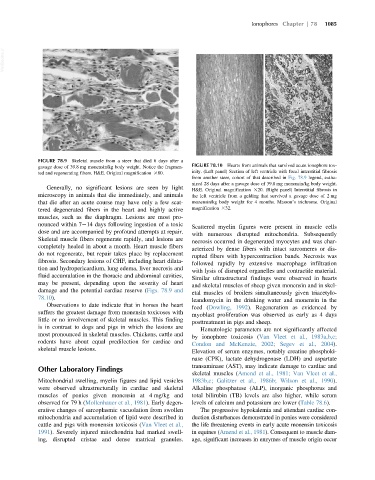Page 1153 - Veterinary Toxicology, Basic and Clinical Principles, 3rd Edition
P. 1153
Ionophores Chapter | 78 1085
VetBooks.ir
FIGURE 78.9 Skeletal muscle from a steer that died 6 days after a
gavage dose of 39.8 mg monensin/kg body weight. Notice the fragmen- FIGURE 78.10 Hearts from animals that survived acute ionophore tox-
ted and regenerating fibers. H&E. Original magnification 380. icity. (Left panel) Section of left ventricle with focal interstitial fibrosis
from another steer, cohort of that described in Fig. 78.9 legend, eutha-
nized 28 days after a gavage dose of 39.8 mg monensin/kg body weight.
Generally, no significant lesions are seen by light
H&E. Original magnification 320. (Right panel) Interstitial fibrosis in
microscopy in animals that die immediately, and animals the left ventricle from a gelding that survived a gavage dose of 2 mg
that die after an acute course may have only a few scat- monensin/kg body weight for 4 months. Masson’s trichrome. Original
tered degenerated fibers in the heart and highly active magnification 332.
muscles, such as the diaphragm. Lesions are most pro-
nounced within 7 14 days following ingestion of a toxic
Scattered myelin figures were present in muscle cells
dose and are accompanied by profound attempts at repair.
with numerous disrupted mitochondria. Subsequently
Skeletal muscle fibers regenerate rapidly, and lesions are
necrosis occurred in degenerated myocytes and was char-
completely healed in about a month. Heart muscle fibers
acterized by dense fibers with intact sarcomeres or dis-
do not regenerate, but repair takes place by replacement
rupted fibers with hypercontraction bands. Necrosis was
fibrosis. Secondary lesions of CHF, including heart dilata-
followed rapidly by extensive macrophage infiltration
tion and hydropericardium, lung edema, liver necrosis and
with lysis of disrupted organelles and contractile material.
fluid accumulation in the thoracic and abdominal cavities,
Similar ultrastructural findings were observed in hearts
may be present, depending upon the severity of heart
and skeletal muscles of sheep given monensin and in skel-
damage and the potential cardiac reserve (Figs. 78.9 and
etal muscles of broilers simultaneously given triacetylo-
78.10).
leandomycin in the drinking water and monensin in the
Observations to date indicate that in horses the heart feed (Dowling, 1992). Regeneration as evidenced by
suffers the greatest damage from monensin toxicoses with
myoblast proliferation was observed as early as 4 days
little or no involvement of skeletal muscles. This finding
posttreatment in pigs and sheep.
is in contrast to dogs and pigs in which the lesions are
Hematologic parameters are not significantly affected
most pronounced in skeletal muscles. Chickens, cattle and
by ionophore toxicosis (Van Vleet et al., 1983a,b,c;
rodents have about equal predilection for cardiac and
Condon and McKenzie, 2002; Segev et al., 2004).
skeletal muscle lesions.
Elevation of serum enzymes, notably creatine phosphoki-
nase (CPK), lactate dehydrogenase (LDH) and aspartate
transaminase (AST), may indicate damage to cardiac and
Other Laboratory Findings
skeletal muscles (Amend et al., 1981; Van Vleet et al.,
Mitochondrial swelling, myelin figures and lipid vesicles 1983b,c; Galitzer et al., 1986b; Wilson et al., 1990).
were observed ultrastructurally in cardiac and skeletal Alkaline phosphatase (ALP), inorganic phosphorus and
muscles of ponies given monensin at 4 mg/kg and total bilirubin (TB) levels are also higher, while serum
observed for 79 h (Mollenhauer et al., 1981). Early degen- levels of calcium and potassium are lower (Table 78.6).
erative changes of sarcoplasmic vacuolation from swollen The progressive hypokalemia and attendant cardiac con-
mitochondria and accumulation of lipid were described in duction disturbances demonstrated in ponies were considered
cattle and pigs with monensin toxicosis (Van Vleet et al., the life threatening events in early acute monensin toxicosis
1991). Severely injured mitochondria had marked swell- in equines (Amend et al., 1981). Consequent to muscle dam-
ing, disrupted cristae and dense matrical granules. age, significant increases in enzymes of muscle origin occur

